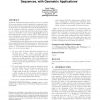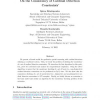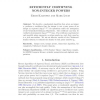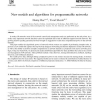148 search results - page 7 / 30 » Formally Analyzing Expected Time Complexity of Algorithms Us... |
ICPP
2006
IEEE
14 years 1 months ago
2006
IEEE
Space filling curves (SFCs) are widely used for parallel domain decomposition in scientific computing applications. The proximity preserving properties of SFCs are expected to k...
COMPGEOM
2011
ACM
12 years 11 months ago
2011
ACM
Forbidden substructure theorems have proved to be among of the most versatile tools in bounding the complexity of geometric objects and the running time of geometric algorithms. T...
AI
2005
Springer
13 years 7 months ago
2005
Springer
We present a formal model for qualitative spatial reasoning with cardinal directions utilizing a co-ordinate system. Then, we study the problem of checking the consistency of a se...
CC
2010
Springer
13 years 5 months ago
2010
Springer
We describe a randomized algorithm that, given an integer a, produces a certificate that the integer is not a pure power of an integer in expected (log a)1+o(1) bit operations unde...
CN
2002
13 years 7 months ago
2002
In todays IP networks most of the network control and management tasks are performed at the end points. As a result, many important network functions cannot be optimized due to la...




